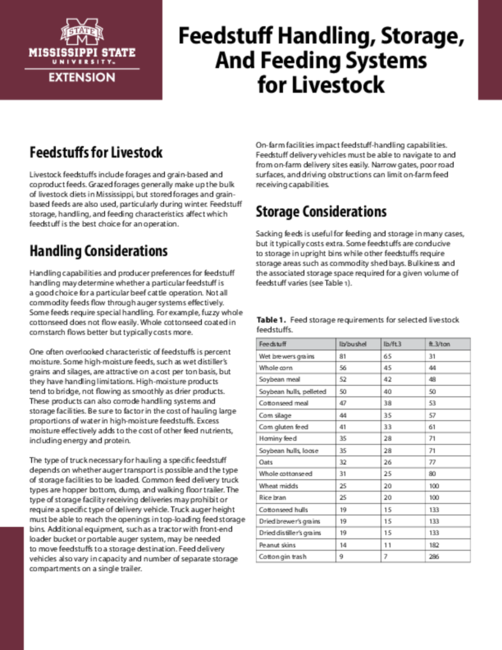P2570
Feedstuff Handling, Storage, and Feeding Systems for Livestock
Feedstuffs for Livestock
Livestock feedstuffs include forages and grain-based and coproduct feeds. Grazed forages generally make up the bulk of livestock diets in Mississippi, but stored forages and grain-based feeds are also used, particularly during winter. Feedstuff storage, handling, and feeding characteristics affect which feedstuff is the best choice for an operation.
Handling Considerations
Handling capabilities and producer preferences for feedstuff handling may determine whether a particular feedstuff is a good choice for a particular beef cattle operation. Not all commodity feeds flow through auger systems effectively. Some feeds require special handling. For example, fuzzy whole cottonseed does not flow easily. Whole cottonseed coated in cornstarch flows better but typically costs more.
One often overlooked characteristic of feedstuffs is percent moisture. Some high-moisture feeds, such as wet distiller’s grains and silages, are attractive on a cost per ton basis, but they have handling limitations. High-moisture products tend to bridge, not flowing as smoothly as drier products. These products can also corrode handling systems and storage facilities. Be sure to factor in the cost of hauling large proportions of water in high-moisture feedstuffs. Excess moisture effectively adds to the cost of other feed nutrients, including energy and protein.
The type of truck necessary for hauling a specific feedstuff depends on whether auger transport is possible and the type of storage facilities to be loaded. Common feed delivery truck types are hopper bottom, dump, and walking floor trailer. The type of storage facility receiving deliveries may prohibit or require a specific type of delivery vehicle. Truck auger height must be able to reach the openings in top-loading feed storage bins. Additional equipment, such as a tractor with front-end loader bucket or portable auger system, may be needed to move feedstuffs to a storage destination. Feed delivery vehicles also vary in capacity and number of separate storage compartments on a single trailer.
On-farm facilities impact feedstuff-handling capabilities. Feedstuff delivery vehicles must be able to navigate to and from on-farm delivery sites easily. Narrow gates, poor road surfaces, and driving obstructions can limit on-farm feed receiving capabilities.
Storage Considerations
Sacking feeds is useful for feeding and storage in many cases, but it typically costs extra. Some feedstuffs are conducive to storage in upright bins while other feedstuffs require storage areas such as commodity shed bays. Bulkiness and the associated storage space required for a given volume of feedstuff varies (see Table 1).
Table 1. Feed storage requirements for selected livestock feedstuffs.
|
Feedstuff |
lb/bushel |
lb/ft.3 |
ft.3/ton |
|
Wet brewers grains |
81 |
65 |
31 |
|
Whole corn |
56 |
45 |
44 |
|
Soybean meal |
52 |
42 |
48 |
|
Soybean hulls, pelleted |
50 |
40 |
50 |
|
Cottonseed meal |
47 |
38 |
53 |
|
Corn silage |
44 |
35 |
57 |
|
Corn gluten feed |
41 |
33 |
61 |
|
Hominy feed |
35 |
28 |
71 |
|
Soybean hulls, loose |
35 |
28 |
71 |
|
Oats |
32 |
26 |
77 |
|
Whole cottonseed |
31 |
25 |
80 |
|
Wheat midds |
25 |
20 |
100 |
|
Rice bran |
25 |
20 |
100 |
|
Cottonseed hulls |
19 |
15 |
133 |
|
Dried brewer’s grains |
19 |
15 |
133 |
|
Dried distiller’s grains |
19 |
15 |
133 |
|
Peanut skins |
14 |
11 |
182 |
|
Cotton gin trash |
9 |
7 |
286 |
Storage life is an important consideration in feedstuff selection. For example, wet distiller’s grain has a relatively short storage life. The humid, warm Mississippi climate is not conducive to long-term storage of feeds that rapidly mold or spoil. Be aware of the physical characteristics of feedstuffs, such as high- moisture content, that increase the likelihood of quality losses, deterioration, or spoilage. Feedstuff usage rates should match the acceptable storage window of the feedstuff supply.
Feed storage facilities do not need to be fancy or expensive. They just need to be functional and well-maintained. To keep feed storage facility development costs down, commodity sheds can be made from existing ranch structures. Secondhand feed storage bins can be repaired and installed to reduce costs.
Refer to MSU Extension Publication 2540 Hay Storage: Dry Matter Losses and Quality Changes for a detailed discussion on storing forages.
Feed Delivery Considerations
On-farm feed mixing and delivery systems also determine the selection of feedstuffs. Particle size and other mixing characteristics can affect the flexibility of including a specific feedstuff as part of a mixed feed. Effective salt-limited feedstuffs require a consistent blend of salt and feed so that salt does not settle to the bottom of the mixture. Therefore, protein meals, such as soybean and cottonseed meals, are good delivery agents for salt due to their fine particle size.
The physical properties of hay play a role when it is used in grinder or mixing systems. If hay is coarse and has a lot of stems, it may fluff up in the grinder, not allowing for a good mixture or good chop. If a loose mineral or other feed that is denser or smaller in particle size is mixed into such a situation, the mixture may separate. Feeding this separated product may harm the performance and digestive health of livestock. In these cases, add water to the mixture with care. Use this mixed feed within 2 to 3 days, or it may spoil or mold.
Similarly, mineral and vitamin supplements have small particles and should be mixed with other feed ingredients as a small part of the final product. They are often purchased as premixes. These premixes must be mixed with other feed ingredients to achieve a consistent mixture. Some mixing equipment is not capable of achieving the necessary mixtures of mineral and vitamin supplements. Inconsistent mixtures can be toxic to livestock. The same can be true for feed additives. Incorporate all premixes into the rations according to label directions.
To produce a safe and effective feed product, it is critical to carefully calculate how much of each ingredient to add to a final blend. Decimal place errors, miscalculations, or feed mixing errors can put livestock feeding programs and animal health at risk. Always check the mixture consistency for any noticeable differences or any ingredient separation. Submit samples of the total mix for nutrient analysis to compare formulated values to actual values. Be sure to read and follow feed additive label instructions carefully.
The feeder type impacts feed choice. If feedstuffs are likely to cake or flow poorly in bulk self-feeders, select alternate feedstuff or feeding methods. Check self-feeders frequently to ensure that feed is flowing without obstruction. An obstruction might cause animals to miss meals and go hungry. Problems occur when obstructions break free and livestock engorge themselves on the feed they have been missing.
Some feed ingredients should not be fed free-choice to livestock. Because of acidosis risk, high-starch and high-energy feeds are not recommended for use in a self-feeder unless a limiter is used in the ration. Likewise, self-feeders that allow unlimited access to feedstuffs are not suitable for some classes of livestock or management scenarios. In addition, even feeds that will be fed free-choice eventually must be limit-fed initially. Introducing new feedstuffs often requires a step-up program where feeding amounts are gradually increased over time. Be sure to properly manage the use of bulk feeders or other feeding methods.
Feeder construction affects what feeds and the type of livestock that can be fed in it. Metal feeders can corrode when exposed to salt-containing feeds or high-moisture feeds, such as wet distiller’s grains. Some classes of livestock, such as bulls, can physically damage feeders. Feeders should be designed to resist damage from livestock, prevent animal injuries on damaged feeders, and ensure durability. Replacing damaged feeders increases operational costs.
Feeder design impacts animal access to feedstuffs and their ability to waste feedstuffs during feeding. If feeders are overturned by animals, feed waste can become a major problem. Some feeders are designed to protect feedstuffs from rain damage. Even covered feeders sometimes allow feedstuffs to get wet, so place feeders carefully to block as much rain as possible.
When offering feedstuffs to livestock, make sure to provide enough trough (bunk) space for the size, class, and number of animals to be fed. At least 12 inches of linear trough space per calf or 18 inches of linear trough space per mature cow is recommended. Social hierarchy and dominance behaviors exhibited by “boss” animals can reduce feeding opportunities for more timid animals. Observe animals closely during feeding and be sure that all livestock in the herd can access feedstuffs. Providing additional trough space or increasing spacing between individual feeders may be necessary.
Timing of feed delivery is also important. Inconsistent feed delivery, such as skipping feedings or feeding erratically, can lower livestock performance and may put animals at risk for digestive problems. Breaking a single daily feeding into multiple smaller feedings, such as twice-a-day feedings, offers production benefits in some cases. In other cases, the benefits are small and outweighed by the added labor requirements. Proper feed bunk management also involves recognizing when to maintain, increase, or decrease feeding quantities based on feed amounts consumed or left in the trough between feedings. Work with a qualified nutritionist to determine the best feeding strategy for the operation.
Management Concerns
Feed handling, storage, and delivery equipment must be maintained and kept clean for proper feed use and animal safety. Feed may cake and mold along the walls of bulk storage bins and feeders. Long-term feed storage or storage under less than ideal conditions may cause spoiled feed. Rusty or corroded feeders may have sharp edges that are dangerous to livestock. Wooden feeders may have hazards such as broken boards or protruding nails.
Thorough equipment cleaning requires more than just emptying the containers prior to refilling. It often means scraping and rinsing equipment interiors. Repair and maintain equipment routinely. Patch holes to limit feed waste and protect feedstuffs from rain, wind, rodent, bird, and insect damage. Metal feeders may need rust protection and paint applications.
Before beginning a new feeding regimen, take time to evaluate the capability of the facilities at hand. The nutritional value of feedstuff is important, but it is not the only factor in proper livestock feeding. If bins, equipment, or feeders are in disrepair and feeds cannot be stored, handled, and delivered properly, the nutritional needs of livestock may not be met. Making optimal use of feedstuff helps ensure that the feeding system is safe and economical. For more information on livestock feed handling, storage, or feeding or related topics, contact your local MSU Extension office.
Reference
Galyean, M. L., Malcolm-Callis, K.J., Garcia, D.R., & Pulsipher, G.D. (1992). Effects of varying the pattern feed composition on performance by programmed fed beef steers. Clayton Livestock Res. Ctr. Prog. Rep. No. 78. N.M. Agric. Exp. Sta., Las Cruces.
Publication 2570 (POD-01-24)
Reviewed by Brandi Karisch, PhD, Associate Extension/Research Professor, Animal and Dairy Sciences, from a previous version by Jane A. Parish, PhD, Professor and Head, North Mississippi Research and Extension Center; J. Daniel Rivera, PhD, former Associate Extension/Research Professor, South Mississippi Branch Experiment Station; and Holly T. Boland, PhD, former Assistant Extension and Research Professor, Prairie Research Unit.
Contacts
-
Brandi Karisch Assoc Extension/Research Prof

- Animal & Dairy Science
